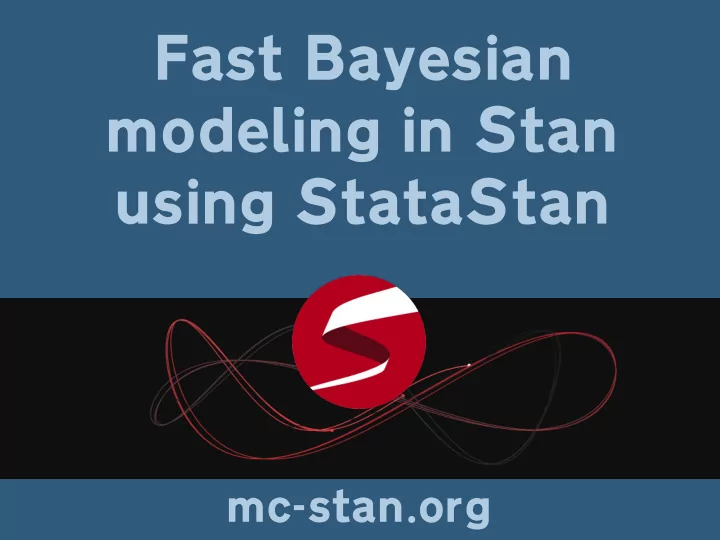

Fast Bayesian modeling in Stan using StataStan mc-stan.org
Robert Grant Kingston University + St George ’ s, University of London www.robertgrantstats.co.uk Collaborative work including: Bob Carpenter Daniel Furr Andrew Gelman Daniel Lee Sophia Rabe-Hesketh
Hamiltonian Monte Carlo Speed (rotation-invariance + convergence + mixing) Flexibility of priors Stability to initial values See Radford Neal ’ s chapter in the Handbook of MCMC
Hamiltonian Monte Carlo Tuning is tricky One solution is the No U-Turn Sampler (NUTS) Stan is a C++ library for NUTS (and variational inference, and L-BFGS)
http://www.stat.columbia.edu/ ~ gelman/research/published/nuts.pdf
Some simulations Daniel Furr is first author; paper forthcoming
Rasch model (item-response) Hierarchical Rasch model (includes hyperpriors)
Hierarchical Rasch model (includes hyperpriors)
Hierarchical Rasch model (includes hyperpriors)
data { int<lower=1> N; int<lower=1> I; int<lower=1> P; int<lower=1, upper=I> ii[N]; int<lower=1, upper=P> pp[N]; int<lower=0, upper=1> y[N]; } parameters { real<lower=0, upper=5> sigma; real<lower=0, upper=5> tau; real mu; vector[I] delta; vector[P] theta; } model { vector[N] eta; theta ~ normal(0, sigma); delta ~ normal(0, tau); mu ~ normal(0, 5); for(n in 1:N) { eta[n] <- mu + theta[pp[n]] + delta[ii[n]]; } y ~ bernoulli_logit(eta); }
data { int<lower=1> N; int<lower=1> I; int<lower=1> P; int<lower=1, upper=I> ii[N]; int<lower=1, upper=P> pp[N]; int<lower=0, upper=1> y[N]; } parameters { real<lower=0, upper=5> sigma; real<lower=0, upper=5> tau; real mu; vector[I] delta; vector[P] theta; } model { vector[N] eta; theta ~ normal(0, sigma); delta ~ normal(0, tau); mu ~ normal(0, 5); for(n in 1:N) { eta[n] <- mu + theta[pp[n]] + delta[ii[n]]; } y ~ bernoulli_logit(eta); }
data { int<lower=1> N; int<lower=1> I; int<lower=1> P; int<lower=1, upper=I> ii[N]; int<lower=1, upper=P> pp[N]; int<lower=0, upper=1> y[N]; } parameters { real<lower=0, upper=5> sigma; real<lower=0, upper=5> tau; real mu; vector[I] delta; vector[P] theta; } model { vector[N] eta; theta ~ normal(0, sigma); delta ~ normal(0, tau); mu ~ normal(0, 5); for(n in 1:N) { eta[n] <- mu + theta[pp[n]] + delta[ii[n]]; } y ~ bernoulli_logit(eta); }
80-280 times faster is not just luxury
stan (Stata command) // make your data clear set obs 10 gen y=0 replace y=1 in 2 replace y=1 in 10 count global N=r(N)
stan (Stata command) data { int<lower=0> N; int<lower=0,upper=1> y[N]; } parameters { real<lower=0,upper=1> theta; } model { theta ~ beta(1,1); for (n in 1:N) { y[n] ~ bernoulli(theta); } }
stan (Stata command) // Version 1: write a separate model file // call Stan, providing the modelfile option stan y, modelfile("bernoulli.stan") /// cmd("$cmdstandir") globals("N")
stan (Stata command) /* Version 2: specify the model inline, the John Thompson way (in a comment block), naming THIS do-file in the thisfile option */ /* data { ... } */ // call Stan with the inline and thisfile options. // modelfile now tells it where to save your model stan y, inline modelfile("inline-bernoulli.stan") /// thisfile("bernoulli.do") /// cmd("$cmdstandir") globals("N") load mode
stan (Stata command) /* Version 3: use the comment block, but don't provide thisfile – Stata will go looking for it in c(tmpdir), which saves you typing in the do-file name and path, but might not work sometimes */ /* data { ... } */ // call Stan with the inline and thisfile options. // modelfile now tells it where to save your model stan y, inline modelfile("inline-bernoulli.stan") /// cmd("$cmdstandir") globals("N") load mode
stan (Stata command) /* Version 4: inline model, the Charles Opondo way */ tempname writemodel file open `writemodel' using "mystanmodel.stan", write #delimit ; foreach line in "data { " " int<lower=0> N; " ... #delimit cr file write `writemodel' "`line'" _n } file close `writemodel' stan y, modelfile("mystanmodel.stan") /// cmd("$cmdstandir") globals("N") load mode
stan _ schools Shortcut command to plug your data into the BUGS Example called “ schools ” stan_schools y lrt vr female, /// globals("N M") hetvar(lrt) /// clusterid(school) /// rslopes(s_denom s_gender) /// betapriors("normal(0,100)") /// stanopts(cmdstandir("$cdir") mode) https://github.com/stan-dev/example-models/wiki/BUGS-Examples
stan _ rasch Shortcut command to plug your data into the Rasch IRT model stan_rasch y, globals("N P I") /// personid(pp) itemid(ii) /// deltapriors("normal(0,100)") /// thetapriors("normal(0,100)") /// stanopts(cmdstandir("$cdir") mode)
stan _c14cal Shortcut command to plug your data into Andrew Millard's radiocarbon calibration stan_c14cal m xdate sigma, /// globals("mintheta" "maxtheta" /// "nDate") /// curve("c1986") /// stanopts(cmdstandir("$cdir") mode) http://community.dur.ac.uk/a.r.millard/BUGS4Arch.html
Spin-offs: windowsmonitor Shows the result of a long winexec call (like Stan) in Stata while it ’ s running This just happens under Linux and Mac, but not Windows... windowsmonitor, waitsecs(20)/// command("ping 127.0.0.1 – n 30")
More spin-offs using the inline code idea statar statacpp
Getting started http://mc-stan.org/interfaces/cmdstan.html https://github.com/stan-dev/statastan
Recommend
More recommend